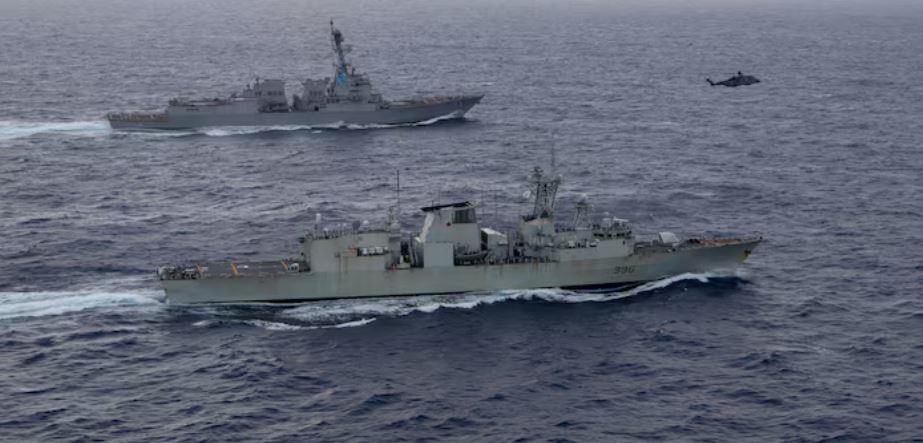In a recent development that has heightened geopolitical tensions in the Indo-Pacific region, a Canadian warship, the HMCS Montreal, navigated the Taiwan Strait on July 31. This action has elicited a stern rebuke from China, which views the maneuver as a destabilizing force in the already volatile region. Ottawa has framed the passage as a routine exercise in support of its commitment to a free and open Indo-Pacific, but the move has been met with fierce criticism from Beijing.
Canada’s Strategic Posture and Regional Presence
Canada’s Ministry of Defence has characterized the transit of the HMCS Montreal through the Taiwan Strait as part of its broader Indo-Pacific strategy. Defence Minister Bill Blair underscored that this action aligns with Canada’s intent to reinforce its naval presence in the region. “As outlined in our Indo-Pacific Strategy, Canada is increasing the presence of the Royal Canadian Navy in the Indo-Pacific region,” Blair stated, referring to Canada’s strategic plan for the area announced in 2022.
This move is part of a larger pattern of Western naval activities in the Taiwan Strait, an area frequently traversed by U.S. warships and occasionally by allied forces. The presence of Canadian naval vessels in this contested waterway, though less common, underscores a growing commitment to maintaining freedom of navigation and supporting regional stability.
China’s Response: Accusations of Provocation
China has reacted strongly to the Canadian warship’s passage through the Taiwan Strait. Li Xi, a spokesperson for the People’s Liberation Army (PLA) Eastern Theater Command, accused Canada of “harassing and disrupting the situation” and undermining peace and stability in the strait. Li emphasized that Chinese forces remain on high alert and are prepared to counter any perceived threats or provocations.
China’s stance on the Taiwan Strait is rooted in its claim of sovereignty over Taiwan, which it considers a breakaway province. Beijing insists on its jurisdiction over the strait, despite international assertions that it is an international waterway. The Chinese government has condemned any foreign military presence in the area, viewing such activities as infringements on its territorial claims.
Historical Context and Regional Implications
The recent transit of the HMCS Montreal is not an isolated incident. Last November, a joint transit by the U.S. destroyer USS Rafael Peralta and the Royal Canadian Navy’s HMCS Ottawa also drew attention. This was followed by another joint U.S.-Canada drill in the strait in June, during which a Chinese warship came dangerously close to a U.S. destroyer, an encounter described by the Pentagon as “unsafe.”
Taiwan’s defence ministry has asserted control over the surrounding sea and airspace during the Canadian frigate’s transit, describing the situation as normal. This assertion reflects Taiwan’s ongoing efforts to assert its sovereignty amidst escalating regional tensions. The island’s military readiness and its control over the strait are critical factors in maintaining stability in the region.
Broader Geopolitical Context
The navigation of the Taiwan Strait by Western naval forces, including Canadian vessels, is part of a broader strategy to challenge China’s expansive territorial claims and support regional allies. The presence of these warships serves as a counterbalance to China’s assertive stance in the Indo-Pacific.
As regional dynamics continue to evolve, the role of naval operations in contested areas like the Taiwan Strait will likely remain a point of contention. The interactions between Western and Chinese forces in these waters highlight the delicate balance of power and the ongoing struggle for influence in the Indo-Pacific region.
Summary
The recent passage of the Canadian warship HMCS Montreal through the Taiwan Strait has ignited tensions with China, reflecting broader geopolitical struggles in the Indo-Pacific. While Canada views the maneuver as a routine exercise in support of regional stability, China perceives it as a provocative action undermining peace. This incident underscores the complex interplay of international naval operations and regional security dynamics.
Key Learning Points:
| Key Point | Details |
|---|---|
| Canadian Warship Passage | HMCS Montreal transits Taiwan Strait on July 31, 2024. |
| China’s Reaction | Accused Canada of disrupting peace and stability. |
| Regional Context | Highlights ongoing geopolitical tensions and sovereignty claims. |
| Historical Incidents | Previous joint U.S.-Canada transits and Chinese reactions. |
| Taiwan’s Response | Asserted control over strait during transit; situation deemed normal. |
Soumya Smruti Sahoo is a seasoned journalist with extensive experience in both international and Indian news writing. With a sharp analytical mind and a dedication to uncovering the truth, Soumya has built a reputation for delivering in-depth, well-researched articles that provide readers with a clear understanding of complex global and domestic issues. Her work reflects a deep commitment to journalistic integrity, making her a trusted source for accurate and insightful news coverage.



